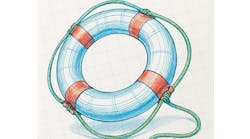Bela Liptak has discussed whether we can control the climate using process automation principles in many of his columns. However, what about the effects of climate change? Flooding, severe storms, hurricanes, etc., can we control that? Or at least be prepared for the results of severe weather? It seems engineers might be starting to do just that here in the United States.
A recent article in Chicago Tribune titled “Drones, supercomputers and sonar deployed against floods,” by Adrian Sainz and Jeff Martin, details how engineers throughout the country are using drones, supercomputers and sonar technologies to develop simulations and monitor risky areas to help predict flooding and its consequences. In fact, the technology was used during Hurricane Harvey, they report.
According to the article, the effort has been fueled by supercomputers in Virginia and Florida, and during the past three years in service, streamflow data expanded 700-fold, collecting data from 5 million miles of rivers and streams throughout the United States.
“Our models simulate exactly what happens when the rain falls on the Earth and whether it runs off or infiltrates. And so, the current conditions, whether that be snow pack or the soil moisture in the snow pack, well, that’s something we can measure and monitor and know,” explained Ed Clark, director of the National Water Center in Tuscaloosa, Ala., in the article.
The simulations of flooding are created through a software system developed at the University of Mississippi called DSS-WISE, which went live in 2017. Data is collected and reviewed with mapping tools that display the average monthly flow of U.S. waterways, the article reports. Inspectors in the field are able to use smart devices to input data for water levels and locations of inoperable flood gates, seepages, etc. They can also send photos, videos and other information to an emergency center in real time, allowing experts to more immediately respond to the conditions.
Taking it further, the U.S. Army Corps of Engineers is using drones to get imagery of flooded areas that can’t otherwise be accessed, and using high-definition sonar to survey riverbeds to identify areas where maintenance, such as weak spots in levees, is necessary, the article reports.
“These areas are 20 to 80 feet under water, we’d never get to see them without sonar. The water never gets low enough for us to see a lot of these failures,” said Andy Simmerman, a Corps engineer, in the article.





